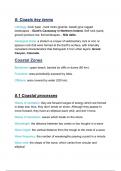8: Coasts key terms
Lithology: (rock type) - hard rocks (granite, basalt) give rugged
landscapes – Giant's Causeway in Northern Ireland. Soft rock (sand,
gravel) produce low, flat landscapes – Nile delta.
Geological strata: a stratum is a layer of sedimentary rock or soil, or
igneous rock that were formed at the Earth's surface, with internally
consistent characteristics that distinguish it from other layers: Grand
Canyon, Colorado.
Coastal Zones
Backshore: upper beach, backed by cliffs or dunes (60 km).
Foreshore: area periodically exposed by tides.
Offshore: area covered by water (320 km).
8.1 Coastal processes
Waves of oscillation: they are forward surges of energy which are formed
in deep sea; thus, they don’t break on shore. Although they appear to
move forward, they have an elliptical wave orbit, and don’t move.
Waves of translation: waves which break on the shore.
Wavelength: the distance between two crests or two troughs in a wave
Wave height: the vertical distance from the trough to the crest of a wave
Wave frequency: the number of wavelengths passing a point in a minute
Wave orbit: the shape of the wave, which varies from circular and
elliptical
, Fetch: the distance of open water a wave travels over
Wave base: the point where there is no further movement related to
wave energy
Swell waves: waves with a long wavelength and low height which travel
vast distances. More common in winter
Storm waves: waves with a short wavelength, great height and high
frequency. More frequent in summer.
Wave shoaling: when a wave shortens, causing it to grow in height
Spilling breakers: associated with gentle beach gradients and steep
waves. Characterised by a gradual peaking of the wave until the crest
becomes unstable, resulting in a gentle spilling forward.
Plunging breakers: occur on steep beaches, with waves of intermediate
steepness. Distinguished by the shore-ward face of the wave becoming
vertical, curling over and plunging forward
Surging breakers: low steepness waves formed in steep beaches. The
front of the crest needs to remain fairly smooth and the wave slides
directly up the beach without breaking. A large proportion of the wave
energy comes back to the sea through backwash.
Swash: energy surge up the beach, with its speed gradually lessened as
it moves up
Backwash: when gravity draws the water back from the shore to the
water
Constructive wave: offshore generated waves with a low frequency
which have a strong swash and a weak backwash, causing deposition.
Destructive wave: generated as the result of locally generated winds with
high frequency which have a strong backwash and a weak swash,
causing erosion




